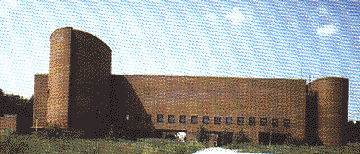 Our
Home in Moscow
Our
Home in Moscow
The Museum of the Paleontological Institute of the Russian Academy
of Sciences in
Moscow is among the largest paleontological museums in the world.
As
with other world-class museums, it displays only a small fraction
of vast collections
of the Paleontological Institute.
In Moscow the Museum was opened for the first
time in 1937, but its history goes
back to the "Kunstkamer" founded
by Peter the Great in St. Petersburg in 1716.
The Kunstcamer, the first public
museum in Russia, was destined to house a
collection of rarities, including some
mammalian fossils of the Ice Age.
When the Academy of Science of Russia was established
in St. Petersburgh in 1725,
all fossil specimens were transferred from the Kunstcamer
to the Mineral Collection of
the Academy, which was transformed subsequently into
the Mineralogical Museum,
and yet again renamed the Geological Museum at the end
of the last century.
In 1930, the Geological Museum was divided into three parts.
One
of them with the fossil collections became the Paleozoological Institute,
once
more renamed the Paleontological Institute.
In 1934, the Institute and its Museum
were moved to Moscow.
From its opening in 1937 and for over forty years, the museum
was located
in Nescuchny Palace, an architectural monument of the 18th century.
Because
of intensive field collecting carried out by the Paleontological Institute
in
many regions of Russia, the former Soviet Republics, as well as in Mongolia and
China,
both its research collections and museum exposition outgrew the facility and had
to
relocate. A new building of a very unusual design was constructed for the
Paleontological
Institue and Museum at the end of the 1970's.
A new Museum of the Paleontological
Institute was completed and opened in 1987.
It occupies 4200 square meters (42,000
square feet) of display space consisting of four
halls: the Hall of the Early
Paleozoic and Invertabrates, the Hall of the Late Paleozoic,
the Mesozoic Hall
(the Age of Dinosaurs), and the Cenozoic Hall (the Age of Mammals).
"Russian
Dinosaur Exhibition" contains just a small, but representative sample from two
halls of the Museum in Moscow - the Hall of the late Paleozoic and the Mesozoic Hall.





